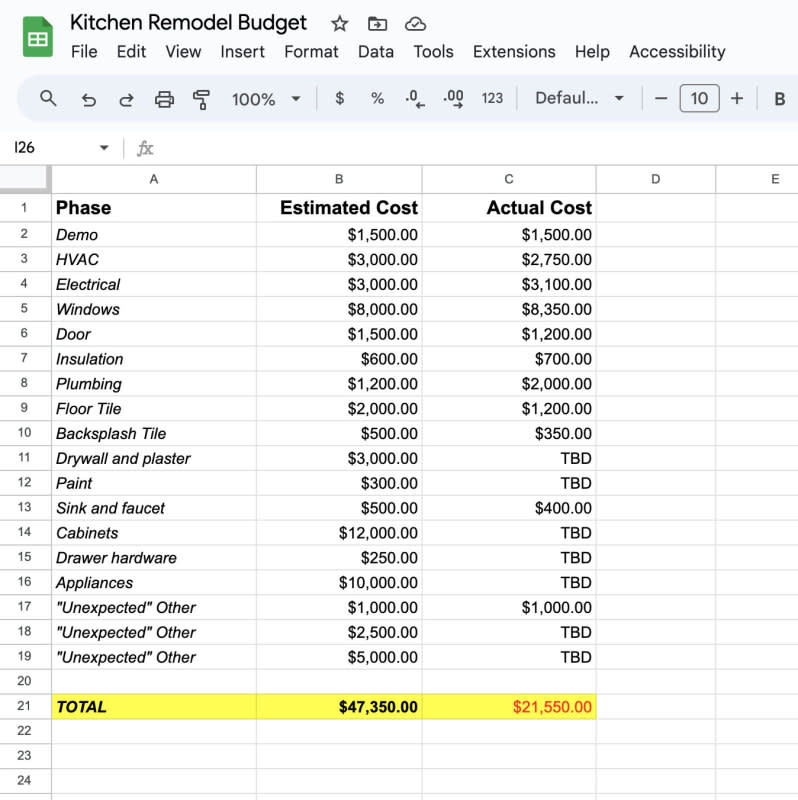How to Plan a Construction Budget
Rising material and labor costs are becoming the #1 reason homeowners are apprehensive about remodeling their homes according to Adobe Acrobat's new home renovation study, which surveyed 1,020 American homeowners about their experiences and thoughts on home remodeling. Though over one-third of homebuyers would rather buy a new home than navigate a remodel, the dream is increasingly unrealistic in many parts of the country. The notion of purchasing a "fixer-upper" or making renovations to the home you already own is thought to be more advantageous; however, research shows that the homeowners who renovate often exceed their budgets, causing delays in construction timelines and unfinished spaces.
Using a templated budget from the ideation phase through active construction is an essential step. It helps homeowners understand the project scope, project costs, and makes it easier to monitor spend from beginning to end. What you didn't know: Adobe Acrobat has a free construction budget template that helps homeowners break down all costs related to your renovation.
Related: Houzz Data Reports on Home Renovation Spending — And it’s More Telling Than You’d Think

Photo by Scott Graham on Unsplash
Challenges Faced When Renovating Without a BudgetThe study asked homeowners to elaborate on the experiences they had when remodeling. Data reports that 48% of new homeowners had remodeled their homes, but 63% went over budget in the process. Of those who admitted to exceeding their planned budget, less than 1% used a PDF template to budget — and only 41% admit they only budgeted with traditional pen and paper. Generationally, 46% of Baby Boomers say they went over budget on remodeling, while Gen Zers appear to have a more realistic understanding of current construction costs.
Without an accurate budget formally mapped and managed, any inexperienced homeowner can face issues that arise as a result of poor planning and a too-limited project budget including:
- Timeline delays (38%)
- Contractor coordination issues (29%)
- Disorganization (25%)
- Effects of supply chain disruption (21%)
- Inspection and approval delays (17%)
- Too many documents (13%)
- Permitting issues (8%)

Emily Fazio
What to Include in Your Home Construction BudgetThe best template includes all spaces and major parts of your home construction project plan. While using the free PDF download is a great start for many homeowners, creating a custom spreadsheet or document is also effective (and still free, if you use a cloud-based spreadsheet like Google Sheets). As an alternative to expensive construction project management tools, it'll help you get granular with the cost estimate vs. actual costs.
- On the X-Axis: List "Phase," "Estimated Cost," and "Actual Cost"
- On the Y-Axis: List each phase of your construction project including, but not limited to: land preparation, foundation, masonry, framing, HVAC, drywall, windows, insulation, deck, paint, and appliances. Include a few "other" spaces to account for indirect costs or uncategorized items for your type of project.
- Fill in the cost estimation column. This breakdown structure allows the homeowner to create an accurate estimate that accounts for all overhead costs and unexpected costs during the construction process.
- Total the columns at the bottom. Remember to update the Actual Costs column with true costs as you realize them, making it possible to monitor the total estimated vs. total spent. When you see costs escalating in one phase, skewing the original budget, you can take proper steps to mitigate scope creep and manage down costs in future phases to stay on a realistic budget. In some ways, this may include watching for sales on appliances, committing to your second choice for floor tile, or opting to DIY the painting to save on the cost of labor.
- Routinely export your budget for the construction team in a PDF format. Actively sharing your budget helps manage project objectives and can help keep the entire project on time. Work with your building and design teams when it comes to scoping labor costs and choosing building materials throughout each step of the project lifecycle.
Adobe adds "Many project managers and construction professionals include dates on their templates to create a weekly budget, so the project team doesn't exceed their available cash flow throughout the project. Dates can be especially helpful if you have recurring bills you need to pay throughout the project, like budgeting for rent payments."
Related: Should You Go Out of Town While Your Home Is Being Renovated?

